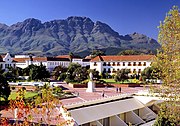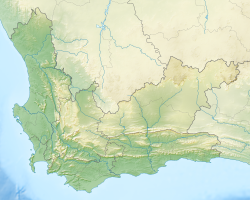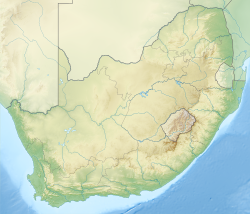Stellenbosch
Stellenbosch
Eikestad | |
|---|---|
Aerial View of Stellenbosch Vineyards Dorp Street Hofmeyr Hall | |
| Nickname: Eikestad( "City of Oaks" ) | |
| Motto(s): | |
| Coordinates:33°56′12″S18°51′41″E/ 33.93667°S 18.86139°E | |
| Country | |
| Province | |
| District | Cape Winelands |
| Municipality | Stellenbosch |
| Established | 1679; 344 years ago |
| Area | |
| • Total | 10.12 km2(3.91 sq mi) |
| Elevation | 136 m (446 ft) |
| Population (2011)[2] | |
| • Total | 77,476 |
| • Density | 7,700/km2(20,000/sq mi) |
| Racial makeup (2011) | |
| •White | 66.6% |
| •Coloured | 15.8% |
| •Black African | 15.0% |
| •Indian/Asian | 0.9% |
| • Other | 1.7% |
| First languages(2011) | |
| •Afrikaans | 70.4% |
| •English | 20.8% |
| •Xhosa | 1.8% |
| • Other | 7.0% |
| Time zone | UTC+2(SAST) |
| Postal code(street) | 7600 |
| PO box | 7599 |
| Area code | 021 |
| Website | www |
Stellenbosch(/ˈstɛlənbɒs/;[3]Afrikaans:[ˈstælənˌbɔs])[4][5]is a town in theWestern Capeprovince ofSouth Africa,situated about 50 kilometres (31 miles) east ofCape Town,along the banks of theEerste Riverat the foot of theStellenbosch Mountain.The town became known as the City of Oaks orEikestadinAfrikaansandDutchdue to the large number ofoaktrees that were planted by its founder,Simon van der Stel,to grace the streets and homesteads.[6]
Stellenbosch is a popular tourist destination due to its history as the second oldest town in South Africa (dating back to 1679),[7]its many historic buildings that are typical ofCape Dutch architecture,its location in the centre of many famous wine farms, as well as its variety of cafes, restaurants, boutiques and art galleries. The town is home toStellenbosch University,one of South Africa's oldest universities, whose campus and buildings occupies large swathes of the town centre. Stellenbosch also has a modern science park,Technopark,situated on the southern side of the town,[8]which serves as a base for many large companies and startups, includingCapitec Bank(South Africa's second largest retail bank).
Stellenbosch has its own municipality (incorporating the neighbouring towns ofPnielandFranschhoek), adjoining themetropolitan areaof theCity of Cape Town.
History
[edit]
Pre-history
[edit]In 1899Louis PéringueydiscoveredPaleolithicstone toolsof theAcheuleantypeat a site named Bosman's Crossing near the Adam Tas Bridge at the western entrance to Stellenbosch.[9][10]This indicates that human habitation of the area dates as far back as 1 million years. By 10,000 to 20,000 years ago the population, assumed to have been ancestors of theSanpeople, were established in the area.[11]
Founding and early history
[edit]
The town was founded in 1679 by the Governor of theCape Colony,Simon van der Stel,who named it after himself[13]– Stellenbosch means "(van der) Stel's Bush". It is situated on the banks of the Eerste River ( "First River" ), so named as it was the first new river he reached and followed when he went on an expedition over the Cape Flats to explore the territory towards what is now known as Stellenbosch. The town grew so quickly that it became an independent local authority in 1682 and the seat of amagistratewith jurisdiction over 25,000 square kilometers (9,700 sq mi) in 1685.[14]
TheDutchwere skilled in hydraulic engineering and they devised a system of furrows to direct water from the Eerste River in the vicinity of Thibault Street through the town along van Riebeeck Street to Mill Street where amillwas erected.[15][16]Early visitors commented on the oak trees and gardens.[6][17]
During 1690 someHuguenot refugeessettled in Stellenbosch,[18]grapeswere planted in the fertile valleys around Stellenbosch and soon it became the centre of the South Africanwineindustry.[15]
In 1710 a fire destroyed most of the town, including the first church, all the Company property and twelve houses. Only two or three houses were left standing.[19]When the church was rebuilt in 1723 it was located on what was then the outskirts of the town, to prevent a similar incident from destroying it again. This church has been enlarged a number of times since 1723 and is currently known as the "Moederkerk" (Mother Church).
Since the 1800s
[edit]The first school had been opened in 1683, but education in the town began in earnest in 1859 with the opening of a seminary for the Dutch Reformed Church.Rhenish Girls' High School,established in 1860, is the oldest school for girls in South Africa.[20]Agymnasium,known ashet Stellenbossche Gymnasium,was established in 1866. In 1874 some higher classes became Victoria College and then in 1918University of Stellenbosch.
The first men's hostel to be established in Stellenbosch was Wilgenhof, in 1903. In 1905 the first women's hostel to be established in Stellenbosch was Harmonie[1].[21]Harmonie and Wilgenhof were part of the Victoria College. In 1909 an old boy of the school,Paul Roos,captain of the first national rugby team to be called theSpringboks,was invited to become the sixth rector of the school. He remained rector until 1940. On his retirement, the school's name was changed toPaul Roos Gymnasium.
In the early days of theSecond Boer War(1899–1902) Stellenbosch was one of the British military bases, and was used as a "remount" camp; and in consequence of officers who had not distinguished themselves at the front being sent back to it, the expression "to be Stellenbosched"[22]came into use; so much so, that in similar cases officers were spoken of as "Stellenbosched" even if they were sent to some other place.[22]
Population
[edit]At the time of the2011 census,the population of the urban area of Stellenbosch was 77,476, living in 23,730 households, in an area of 20.9 square kilometres (8.1 sq mi). Roughly 70% of the residents spokeAfrikaansas theirhome language,2% spokeisiXhosa,and 21% spokeEnglish.15% of the population identified themselves asBlack African,16% asColoured(racially mixed), and 67% asWhite.[2]
TheStellenbosch Municipalityextends beyond the town of Stellenbosch itself to include rural areas, villages, and the town ofFranschhoek.At the time of the 2011 census, the municipal population was 155,728, while by 2016 it was estimated to be 173,197.[23]In 2017, the municipality estimated that the population in 2018 would increase to 176,523.[24]
The1936 censusrecorded a total population of 8,782 residents with 3,558 of them recorded as Coloured and 4,995 recorded as White.[25]
Climate and geography
[edit]
Stellenbosch is 53 km (33 mi) east ofCape TownviaNational RouteN1.Stellenbosch is in a hilly region of theCape Winelands,and is sheltered in a valley at an average elevation of 136 m (446 ft), flanked on the west by Papegaaiberg (Afrikaans:Parrot Mountain), which is actually a hill.[citation needed]To the south isStellenbosch Mountain;to the east and southeast are theJonkershoek,Drakenstein,andSimonsbergmountains.[citation needed]Die Tweeling Pieke (Afrikaans:The Twin Peaks) has an elevation of 1,494 m (4,902 ft); the highest point is Victoria Peak 1,590 m (5,220 ft).Jonkershoek Nature Reservelies about 9 km (5.6 mi) east of Stellenbosch, and theHelderberg Nature Reserveis about 23 km (14 mi) south viaprovincial routeR44.[citation needed]Just south of the Helderberg Nature Reserve isStrand,aseaside resorttown.[citation needed]The soils of Stellenbosch range from darkalluviumtoclay.[citation needed]This, combined with the well-drained, hilly terrain andMediterranean climate,prove excellent forviticulture.[citation needed]Summers are dry and warm to hot, with some February and March days rising to over 40 °C (104 °F).[citation needed]Winters are cool, rainy and sometimes quite windy, with daytime temperatures averaging 16 °C (61 °F).[citation needed]Snow is usually seen a couple of times in winter on the surrounding mountains.[citation needed]Spring and autumn are colder seasons, when daytime temperatures hover in the 20s.[citation needed]
| Climate data for Stellenbosch, Western Cape | |||||||||||||
|---|---|---|---|---|---|---|---|---|---|---|---|---|---|
| Month | Jan | Feb | Mar | Apr | May | Jun | Jul | Aug | Sep | Oct | Nov | Dec | Year |
| Mean daily maximum °C (°F) | 24.7 (76.5) |
24.6 (76.3) |
20.5 (68.9) |
19.7 (67.5) |
15.4 (59.7) |
11.8 (53.2) |
9.8 (49.6) |
7.3 (45.1) |
11.2 (52.2) |
15.6 (60.1) |
19.5 (67.1) |
23.2 (73.8) |
16.9 (62.5) |
| Mean daily minimum °C (°F) | 11.6 (52.9) |
11.5 (52.7) |
9.5 (49.1) |
6.8 (44.2) |
3.9 (39.0) |
2.3 (36.1) |
0.7 (33.3) |
1.3 (34.3) |
4.3 (39.7) |
6.9 (44.4) |
9 (48) |
11.6 (52.9) |
6.6 (43.9) |
| Averageprecipitationmm (inches) | 33 (1.3) |
35 (1.4) |
36 (1.4) |
60 (2.4) |
95 (3.7) |
141 (5.6) |
127 (5.0) |
107 (4.2) |
86 (3.4) |
68 (2.7) |
53 (2.1) |
37 (1.5) |
878 (34.7) |
| Source:Stellenbosch climate | |||||||||||||
Economy
[edit]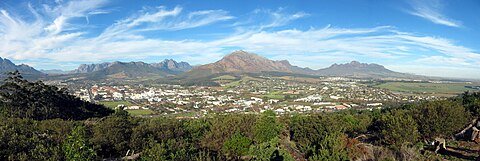
Stellenbosch is home to several corporate headquarters of large and small companies including major South African bank,Capitec Bank,fast-food chain, Hungry Lion, major dairy products groupLactalisSouth Africa, major private hospital group,Mediclinic Internationaland investment holding company,Remgro.
Sport
[edit]Stellenbosch is a warm-weather training venue for cyclists, track and field squads, and triathletes. The Stellenbosch Sports Academy opened its doors in 2012 and hosts several rugby teams on a permanent basis, such as the Springbok Sevens and Western Province.[citation needed]It is also the home base of professionalfootballclubStellenbosch FCwho compete in theDStv Premiership.[26]
Viticulture and winemaking
[edit]
The Stellenbosch,PaarlandFranschhoekvalleys form theCape Winelands,the larger of the two main wine growing regions in South Africa. TheSouth African wineindustry produces about 1,000,000,000 litres of wine annually. Stellenbosch is the primary location for viticulture and viticulture research. ProfessorPeroldwas the first Professor of Viticulture at Stellenbosch University. The Stellenbosch Wine Route established in 1971 by Frans Malan from Simonsig, Spatz Sperling from Delheim, Neil Joubert from Spier and David van Velden from Overgaauw, known as Stellenbosch American Express® Wine Routes since 2002, is a world-renowned and populartouristdestination. This route provides visitors the opportunity to experience a wide range of cultivars and includes farms such as Warwick and JC Le Roux.[27]
The region has aMediterranean climatewith hot dry summers and cool wet winters. Stellenbosch lies at the foot of the Cape Fold mountain range, which provides soil favourable toviticulture.Grapes grown in this area are mainly used for wine production, as opposed totable grapes.The region possesses a wide range of soils in the area, from light, sandy soils to decomposed granite. StellenboschCabernet Sauvignonis beginning to get a good reputation as a fine wine.[28]
Stellenbosch University
[edit]
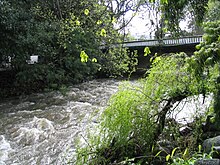
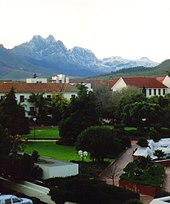
Stellenbosch Universityis one of South Africa's leadinguniversities.[citation needed]This institution has a rich history dating back to 1863 and has 10faculties,includingEngineering,Commerce,ScienceandArts.[citation needed]The Department of Electrical and Electronic Engineering is the only university department in the southern hemisphere which has successfully built a communications satellite Sunsat which was launched in 2000 and orbited the Earth for three years.[citation needed]
The University currently has about 29,000 students. White students in 2014, namely 18,636, constitute 63.4% of all students enrolled.[29]Although the official language of the university isAfrikaans,most post-graduate courses are presented inEnglish.The university is in the process of introducing moreEnglishcentered undergraduate courses following mass protest by the student body. The university council with the concurrence of the senate approved a new language policy on 22 June 2016 for implementation from 1 January 2017. Since the campuses are situated in the Western Cape, the university has committed to introducing multilingualism by using the province’s three official languages, namelyAfrikaans,EnglishandisiXhosa.[30]
List of suburbs
[edit]

- Annandale
- Arbeidslus
- Brandwacht
- Cloetesville
- Coetzenburg
- Dalsig
- Dennesig
- De Zalze
- De Novo
- Devon Valley
- Die Boord, previouslyRhodes Fruit Farms
- Die Rant
- Ida's Valley
- Jamestown
- Jonkershoek
- Karindal
- Kayamandi
- Klapmuts
- Koelenhof
- Krigeville
- Kylemore
- Welbedaght
- La Colline
- Lanquedoc
- Meerlust
- Mostertsdrift
- Onderpapegaaiberg, also known asVoëltjiesdorp
- Paradyskloof
- Plankenberg
- Pniel
- Raithby
- Rozendal
- Simondium
- Simonsrust
- Simonswyk
- Techno Park
- Tennantville
- Town central
- Uniepark
- Universiteitsoord
- Vlottenburg
- Weides
- Welbedaght
- Welgevonden
List of schools
[edit]Primary Schools
- A.F. Louw Primary School
- Bruckner De Villiers Primary School
- Cloetesville Primary School
- Devonvallei Primary School
- Eikestad Primary School
- Idasvallei Primary School
- Ikaya Primary School
- JJ Rhode Primary School
- Kayamandi Primary School
- Koelenhof Primary School
- Lynedoch Primary School
- Rhenish Primary School
- Stellenbosch Primary School
- St Idas A.C. Primary School
- Weber Gedenk Primary School
Secondary Schools
- Bloemhof High School
- Cloetesville High School
- Kayamandi High School
- Luckhoff Secondary School
- Makupula Secondary School
- Paul Roos Gymnasium
- Pieter Langeveldt Primary School
- Rhenish Girls' High School
- Rietenbosch Primary School
- Stellenbosch High School
- Stellenzicht Senior Secondary School
Transport
[edit]Rail
[edit]Stellenbosch lies on the Muldersvlei rail branch of theNorthern Lineoperated byMetrorail Western Capecommuter rail system which connects Stellenbosch withCape Townto the west viaEersterivier,KuilsrivierandBellville.Stellenbosch has two railway stations including its main railway station, Stellenbosch Railway Station to the east of the CBD along theR310Adam Tas Road and Du Toit Railway Station to the north of the CBD in Plankenbrug.
Roads
[edit]
Stellenbosch is not directly linked to any majorfreewayor highway, however it is connected to theN1(toCape TownandPaarl) via the R44 and R304, theN2(to Cape Town andGeorge) via the R44 and R310 and theR300(toBellvilleandMitchells Plain) via the M12.
TheR44(Adam Tas Street; Strand Road) connects Stellenbosch withKlapmutsandWellingtonto the north andSomerset Westto the south. TheR304(Bird Street; Koelenhof Road) connects Stellenbosch withKlipheuwelandAtlantisto the north-west. TheR310(Adams Tas Street; Helshoogte Road) connects Stellenbosch withFranschhoekto the east andMuizenbergto the south-west.
Stellenbosch is also served by twometropolitan routeslinking it to nearby towns in theCity of Cape Town.TheM12(Polkadraai Road) which begins at the intersection with the R310 just outside Stellenbosch connects the town withKuilsrivierand theCape Town International Airportto the west. TheM23(Bottelary Road) which begins at the intersection with the R304 just outside Stellenbosch connects the town with Kuilsrivier,BrackenfellandBellvilleto the north-west.
Bird Street is the main street through Stellenbosch Central stretching for about 2 kilometres in a north–south direction.
Houses of worship
[edit]Notable people
[edit]- Ferdie Bergh– rugby player
- Bernette Beyers– track cyclist
- Kees Bruynzeel– Dutch businessman, timber merchant and yachtsman
- Dirk Coetsee– Chancellor (Hoofdheemraad) of the District of Stellenbosch and Drakenstein in South Africa for most of the 1690s and early 1700s
- Danie Craven– rugby administrator
- Giniel de Villiers– Rally driver
- David Earl– composer and pianist
- Arnu Fourie– Paralympic athlete
- Justin Harding- Golfer
- Hans Heinrich Hattingh- Dutch Cape Colony free burgher, proprietor of the Spier Estate
- Omar Henry– cricketer
- Daniel Hugo– radio producer, lecturer and poet
- Charl Langeveldt– cricketer[citation needed]
- Lee Langeveldt– football player
- D. F. Malan– Prime Minister of South Africa from 1948 to 1954
- Jannie Marais(Johannes Henoch Marais) – mining magnate, politician and philanthropist who co-founded the multi-billion dollar media conglomerate Naspers and the University of Stellenbosch
- JP Pietersen– rugby player
- Paul Roos– South African rugby union captain
- Anton Rupert– entrepreneur, businessman, conservationist
- Johann Rupert– businessman
- Dana Snyman– journalist, writer and playwright[citation needed]
- Conrad Stoltz– 2-time Olympian, 3 timeXterraworld champion[citation needed]
- Roger Telemachus– cricketer
- Sampie Terreblanche– Professor in Economics, co-founder ofDemocratic Party
- Richard Turner– philosopher
- Frederik van Zyl Slabbert– anti-apartheid Member of Parliament and leader of opposition, lecturer in sociology
- Hendrik Verwoerd– "father of apartheid" - Prime Minister of South Africa from 1958 to 1966
Coats of arms
[edit]The municipality currently uses a badge[31]consisting of a fleur de lis and a cross issuing from a stylised bunch of grapes. In the past, the various local authorities used coats of arms.
- Drostdy – The drostdy (1685–1827) was the local authority for the whole Stellenbosch district, including the city. In 1804, when theCape Colonywas ruled by theBatavian Republic,the government assigned an armorial seal to the drostdy. It depicted the shield of arms ofSimon van der Stelsuperimposed on an anchor representing Hope, on a golden background.[32]In 1814, the British occupation authorities ordered the drostdyen to use the royal coat of arms instead.[33]Van der Stel's arms were quartered: 1 two red towers on a golden background; 2 apeacockon a red background; 3 three silver discs or balls stacked 1 over 2 on a red background; 4 a red tower on a golden background. In the centre was a smaller blue shield displaying six silver crescents (or, possibly, ribs) 2, 2, and 2.
- Municipality (1) – The Stellenbosch municipality was formed in 1840, to administer the city, but not the rest of the district. Although it was not the legal successor to the drostdy, it adopted the old drostdy seal of arms. A few changes[34]were made to the arms over the years: quarters 2 and 3 were changed from red to blue; the peacock was turned to a profile position; the three silver discs or balls were changed to golden rings; the central shield was changed from blue to black. Whether any of these changes was intentional, or whether they were the result of artistic errors, is unclear.
- Municipality (2) – The municipal council had a new coat of arms[35]designed by Michael Dawes in 1951. After some improvements, theCollege of Armsgranted them on 26 June 1952. They were registered at theBureau of Heraldryon 31 August 1979.[36]The new design was a golden shield displaying the three towers from the Van der Stel arms, and a red fess displaying the peacock between golden rings. The crest was an anchor entwined with oak leaves and acorns. The mottoFortis et superbus( "Strong and proud" ) was chosen.
- Divisional council (1) – The divisional council, established in 1855, administered the rural areas outside the city. At some point, it adopted the plain Van der Stel arms, i.e. a golden shield displaying three red towers.[citation needed]

- Divisional council (2) – The divisional council had its arms re-designed byCornelis Pamain 1970, and registered them at theBureau of Heraldryon 30 October 1970.[36]The shield was divided down the centre into gold and red, and the three towers were counterchanged. A red tower was added as a crest.
- Kaya Mandi– The local authority for the Black township of Kaya Mandi registered arms at the Bureau on 27 November 1987.[36]
See also
[edit]References
[edit]- ^"Stellenbosch".Retrieved21 July2024.
- ^abcdeCombined population statistics of the Main PlacesStellenbosch,La Colline,andDalsig,which constitute the main urban area.
- ^"Definition of STELLENBOSCH".www.merriam-webster.com.Retrieved16 June2018.
- ^A Universal Pronouncing Gazetteer.Thomas Baldwin, 1852. Philadelphia: Lippincott, Grambo & Co.
- ^A Grammar of Afrikaans.Bruce C. Donaldson. 1993. Berlin: Walter de Gruyter.ISBN3-11-013426-8
- ^abThe Cyclopædia; or, Univeal Dictionary of Arts, Sciences, and Literature.Abraham Rees, 1819. London: Longman, Hurst, Rees, Orme & Brown
- ^"A brief history of our town..."Stellenbosch Municipality.Retrieved23 April2024.
- ^"A business park with a purpose".Technopark.Retrieved23 April2024.
- ^Seddon, J. D. (October 1966). "The Early Stone Age at Bosman's Crossing, Stellenbosch".The South African Archaeological Bulletin.21(83). South African Archaeological Society: 133–137.doi:10.2307/3888433.JSTOR3888433.
- ^Deacon, H. J. (1975). "Demography, Subsistence, and Culture During the Acheulian in Southern Africa". In Butzer, Karl W.; Isaac, Glynn L. (eds.).After the Australopithecines: Stratigraphy, Ecology, and Culture Change in the Middle Pleistocene.Walter de Gruyter. pp. 543–570.ISBN9783110878837.
- ^"WHO LIVED IN THE STELLENBOSCH WINELANDS BEFORE 1652?"(PDF)– via Stellenbosch Heritage.
- ^"Blettermanhuis".Stellenbosch Museum.Retrieved17 April2024.
- ^Fairbridge, Dorothea (1922)."XII – Stellenbosch".Historic houses of South Africa.London: H. Milford, Oxford University press. p. 109.Retrieved31 January2011.
- ^"History of Stellenbosch".ShowMe™ – Stellenbosch.Retrieved6 September2017.
- ^abStatistics of the Colonies of the British Empire in the West Indies, South America, North America, Asia, Austral-Asia, Africa and Europe: From the Official Records of the Colonial Office.Robert Montgomery Martin,1839. London: W.H. Allen and Co. (p. 496)
- ^State of the Cape of Good Hope, in 1822.William Wilberforce Bird.1823. London: J. Murray.
- ^The Life and Labours of George Washington Walker: of Hobart Town, Tasmania.James Backhouse and Charles Tylor, 1862. Tasmania: Thomas Brady (pp. 498–499)
- ^Botha, Colin Graham (1921).The French refugees at the Cape.Cape Town: Cape Times Limited. p. 155.Retrieved31 January2011.
- ^Trotter, A.F. (1903).Old Cape Colony a chronicle of her men and houses from 1652–1806.Westminster: A. Constable & co., ltd. pp. 174, 179.Retrieved31 January2011.
- ^"Rhenish prepare for their 150th birthday".Eikestad News.Eikestadnuus. 17 February 2006. Archived fromthe originalon 20 January 2008.Retrieved13 November2007.
- ^"Huisdinge: Harmonie Dameskoshuis".Sun.ac.za.Retrieved29 July2013.
- ^abJones, Spencer (11 March 2024)."The British Army and the Lessons of the Boer War".War on the Rocks.Retrieved15 March2024.
- ^Community Survey 2016: Provincial profile: Western Cape(PDF)(Report). Statistics South Africa. 2018. p. 8.Retrieved26 July2018.
- ^Stellenbosch Municipality 2017 – Western Cape Government
- ^Malherbe, E.G. (1939).Official Year Book of the Union of South Africa and of Basutoland, Bechuanaland Protectorate, and Swaziland.Vol. 20. Pretoria: Union of South Africa. p. 1044.
- ^"Stellenbosch Football Club About Page".Stellenbosch Football Club.Retrieved17 June2023.
- ^"Stellenbosch American Express® Wine Routes – Our Story".Archived fromthe originalon 9 February 2014.Retrieved2 March2014.
- ^The-Wine-LibraryArchived23 January 2009 at theWayback MachineShort Description of wine in Stellenbosch
- ^"Core statistics 2014", Stellenbosch University, 2014, [online]http://www.sun.ac.za/english/statistical-profile-2014-testArchived9 April 2018 at theWayback Machine,Accessed: 04/08/2015
- ^http://www.sun.ac.za/english/Documents/Language/Final%20Language%20Policy%20June%202016.pdf[bare URL PDF]
- ^Stellenbosch
- ^Pama, C. (1965),Lions and Virgins
- ^Cape Town GazetteNo 418 (15 January 1814).
- ^changes
- ^new coat of arms
- ^abcNational Archives of South Africa: Data of the Bureau of Heraldry
External links
[edit]- Stellenbosch Municipality
- Stellenbosch Tourism Bureau
- Eikestad NuusArchived17 March 2015 at theWayback Machine



